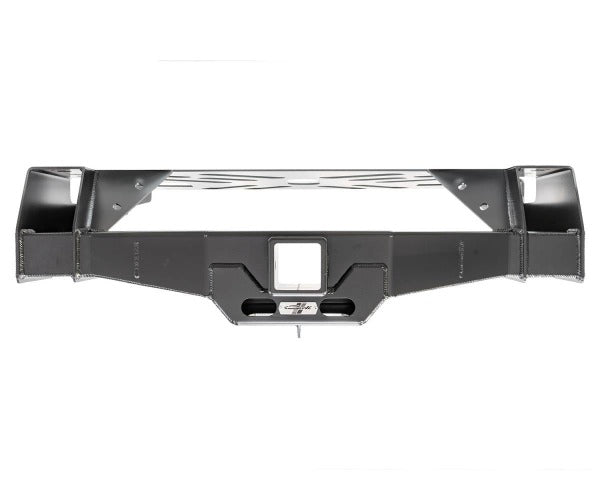

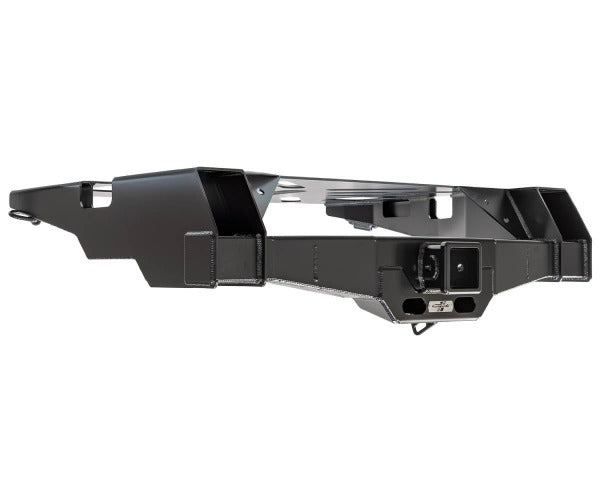

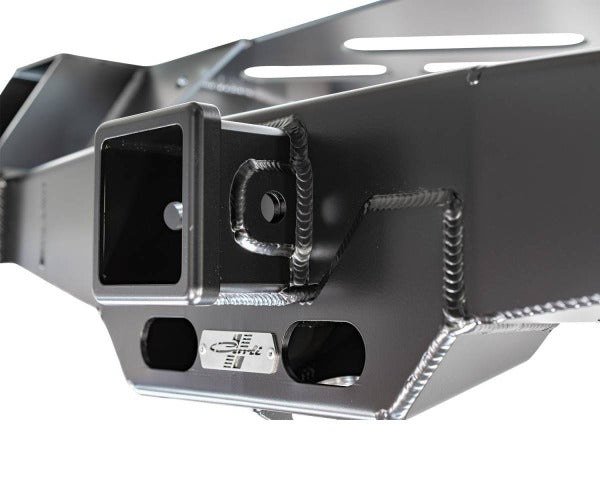
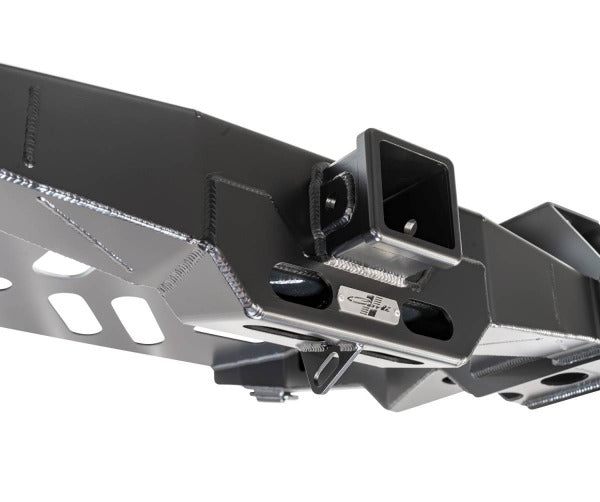
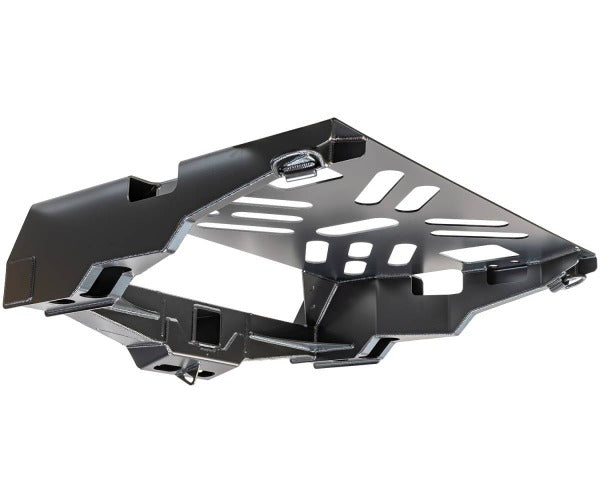
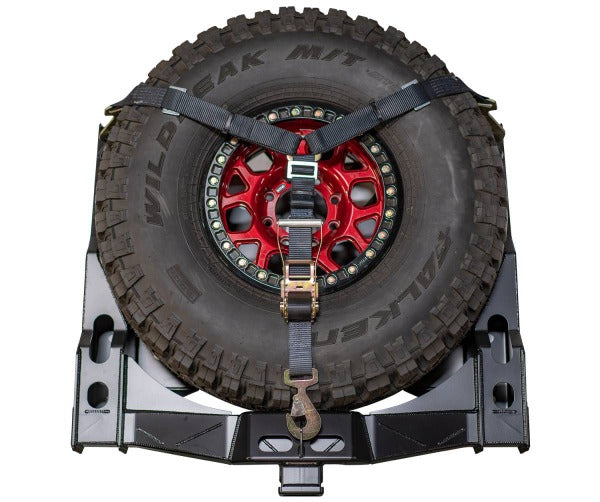
SKU: CS-FHITCH-1723
– Direct Bolt in, Rated to 16,000lbs., 3″ Hitch Receiver
– 3/16″ and 1/4″ Cold-Rolled American Steel
– Utilizes Factory Winch + 3-way Tie-Down to Secure Spare
– 38″ Spare Tire in the Factory Location
– May Require Exhaust Modification
– Requires 5/8″ x 4″ (usable shank) Hitch Pin
– Fitment: F250/F350
NOTE: Spare Tire / Wheel NOT Included.
It may not have been easy to get in and required deflation to remove (and carrying a compressor to inflate) but it was doable. Fast forward to the 4.5″ System Development and the monstrous Super Duty Wheel Wells exhibited by our customers posting pictures of their 40″ meats on our production 4.5″ systems and we knew something had to be done. These customers claimed only “minor trimming” to fit the 40’s so we stepped up to 38″ x 13.5″ M/T knowing full well that, unlike most, we’d be cycling the FULL length of travel and doing it often so it was best to err on the side of caution when stuffing bigger tires. They were a success – very minimal trimming tucked the 38″ without issue but the spare was ratchet strapped in the bed as there was no way to fit it under the bed. Not sure you’d want to crank it into the factory hitch even if it would fit – we saw video evidence of two of our customers running whoop sections dropping their oversized spare tires from the bottom of the bed thanks to a broken factory winch cable. The factory winch cable is far from party-rated!
Testing: Class Five?
We can build a bad-ass hitch, there’s no question about it. With the interest we received from all of you, we wanted to back our confidence with legit testing. For this, we contacted Element Materials Technology in Des Moines, IA. Our request was to test the hitch to 12,000lbs figuring this is where a 2″ receiver would likely top-out in a bumper-pull style trailer. Once Element got their hands on the hitch, they took the initiative to bump it. I Quote:

Come to find out, Class 5 doesn’t exist; 4 is really the highest rated hitch “class”. Anything tested over 4 goes into the 4+ category often referred to as 5. We wanted to test this hitch to SAE standards; their recommendation “SAE J684 2014 to Class 4+ 16,000lbs GCVWR”.
The result, per Element: “The Class 4+ (16,000 lbs GVWR) Weight Carrying hitch component described herein complies with all appropriate portions of the SAE J684-2014.”
It was requested that we send 2 identical hitches for testing – one would be tested to the standard (originally 12K, bumped to a staggering 16K once received and analyzed by test facility) and the second would be tested to failure at their max 20,000lbs. As our hitch passed 16,000lbs with no deflection; as such, they bypassed the 20,000lb “failure” test as they determined this test to be insufficient to cause any sort of failure.
The following tests (and results) were performed in accordance with the standard:
In short, the hitched passed all tests in accordance to the existing SAE standard with flying colors and the people in business to test the hitch to failure couldn’t break it. I guess we’ll throw that one in the win column!
Construction
If you’ve followed this project, you’ll know we never intended to run a 3″ options; well, as the project progressed, this became the F350 (and F250 Tremor/High Capacity Tow) standard. We caved… After playing with the factory hitch and seeing the amount of play in the hitch receiver, we hoped to find something better. Unfortunately, material selection on 3″ Square tubing was slim. We selected the best-fit we could find. It ended up being 3/16″ wall-thickness so we added doublers to the hitch pin and custom-machined caps are welded to the front. This results in a very similar hitch interface as the stock unit – as this was the OEM benchmark and there was no other avenue to pursue – we signed off but it’s worth mentioning as it wasn’t an improved fit over the factory receiver.
A 37″ tire cranks right into position – a 38″ does the same but will require reworking of the factory (and aftermarket) exhaust to clear the massive tire.
SKU: CS-FHITCH-1723
– Direct Bolt in, Rated to 16,000lbs., 3″ Hitch Receiver
– 3/16″ and 1/4″ Cold-Rolled American Steel
– Utilizes Factory Winch + 3-way Tie-Down to Secure Spare
– 38″ Spare Tire in the Factory Location
– May Require Exhaust Modification
– Requires 5/8″ x 4″ (usable shank) Hitch Pin
– Fitment: F250/F350
NOTE: Spare Tire / Wheel NOT Included.
It may not have been easy to get in and required deflation to remove (and carrying a compressor to inflate) but it was doable. Fast forward to the 4.5″ System Development and the monstrous Super Duty Wheel Wells exhibited by our customers posting pictures of their 40″ meats on our production 4.5″ systems and we knew something had to be done. These customers claimed only “minor trimming” to fit the 40’s so we stepped up to 38″ x 13.5″ M/T knowing full well that, unlike most, we’d be cycling the FULL length of travel and doing it often so it was best to err on the side of caution when stuffing bigger tires. They were a success – very minimal trimming tucked the 38″ without issue but the spare was ratchet strapped in the bed as there was no way to fit it under the bed. Not sure you’d want to crank it into the factory hitch even if it would fit – we saw video evidence of two of our customers running whoop sections dropping their oversized spare tires from the bottom of the bed thanks to a broken factory winch cable. The factory winch cable is far from party-rated!
Testing: Class Five?
We can build a bad-ass hitch, there’s no question about it. With the interest we received from all of you, we wanted to back our confidence with legit testing. For this, we contacted Element Materials Technology in Des Moines, IA. Our request was to test the hitch to 12,000lbs figuring this is where a 2″ receiver would likely top-out in a bumper-pull style trailer. Once Element got their hands on the hitch, they took the initiative to bump it. I Quote:

Come to find out, Class 5 doesn’t exist; 4 is really the highest rated hitch “class”. Anything tested over 4 goes into the 4+ category often referred to as 5. We wanted to test this hitch to SAE standards; their recommendation “SAE J684 2014 to Class 4+ 16,000lbs GCVWR”.
The result, per Element: “The Class 4+ (16,000 lbs GVWR) Weight Carrying hitch component described herein complies with all appropriate portions of the SAE J684-2014.”
It was requested that we send 2 identical hitches for testing – one would be tested to the standard (originally 12K, bumped to a staggering 16K once received and analyzed by test facility) and the second would be tested to failure at their max 20,000lbs. As our hitch passed 16,000lbs with no deflection; as such, they bypassed the 20,000lb “failure” test as they determined this test to be insufficient to cause any sort of failure.
The following tests (and results) were performed in accordance with the standard:
In short, the hitched passed all tests in accordance to the existing SAE standard with flying colors and the people in business to test the hitch to failure couldn’t break it. I guess we’ll throw that one in the win column!
Construction
If you’ve followed this project, you’ll know we never intended to run a 3″ options; well, as the project progressed, this became the F350 (and F250 Tremor/High Capacity Tow) standard. We caved… After playing with the factory hitch and seeing the amount of play in the hitch receiver, we hoped to find something better. Unfortunately, material selection on 3″ Square tubing was slim. We selected the best-fit we could find. It ended up being 3/16″ wall-thickness so we added doublers to the hitch pin and custom-machined caps are welded to the front. This results in a very similar hitch interface as the stock unit – as this was the OEM benchmark and there was no other avenue to pursue – we signed off but it’s worth mentioning as it wasn’t an improved fit over the factory receiver.
A 37″ tire cranks right into position – a 38″ does the same but will require reworking of the factory (and aftermarket) exhaust to clear the massive tire.












